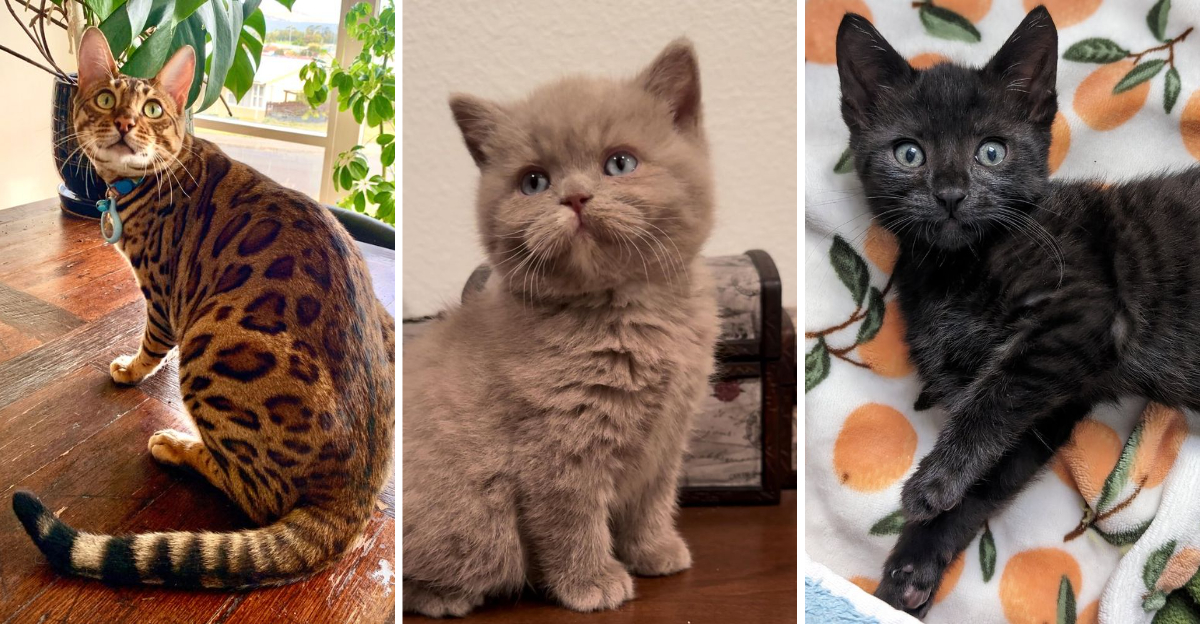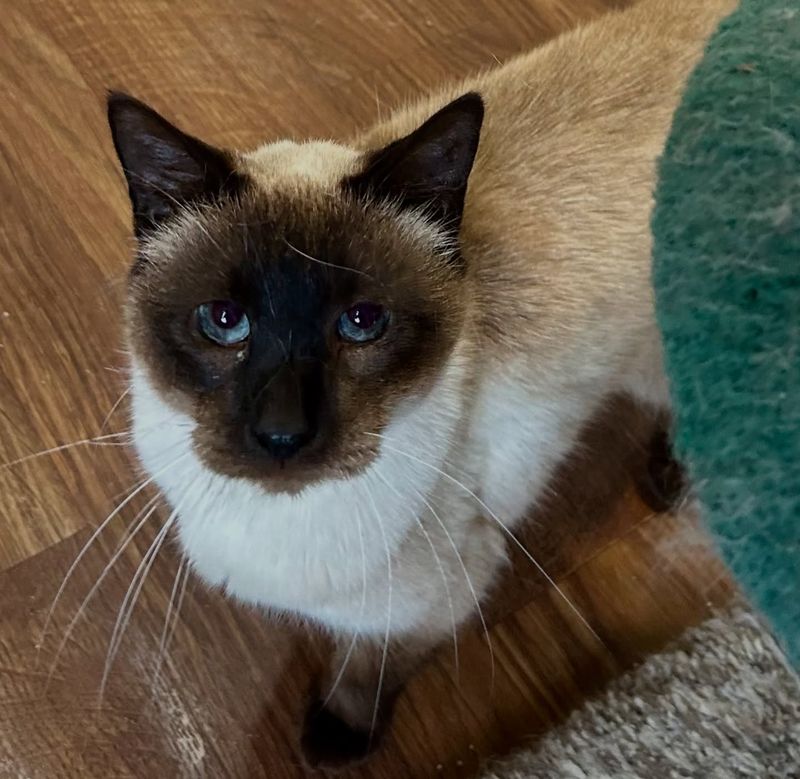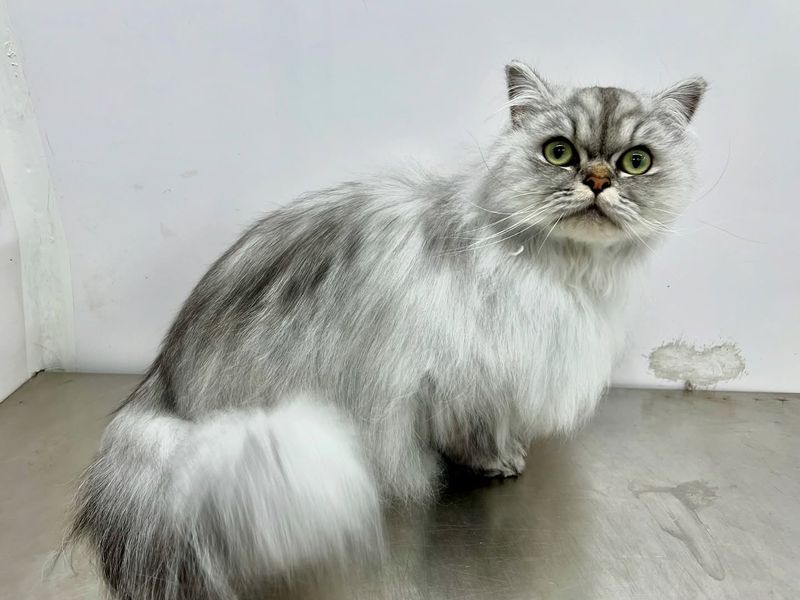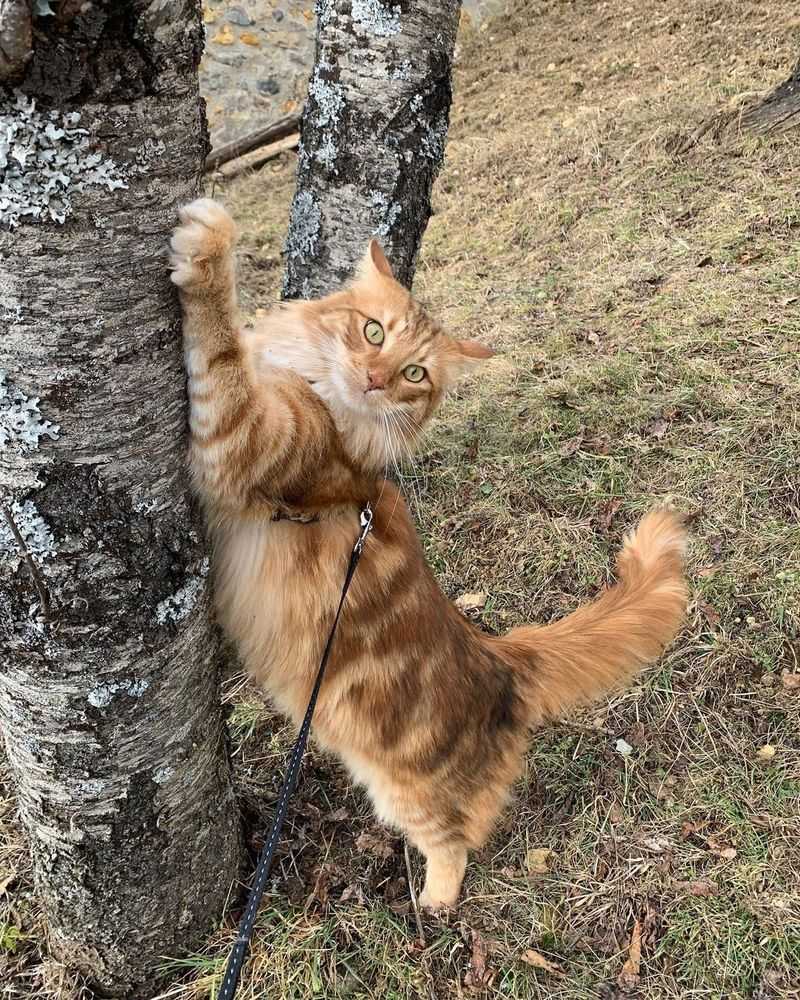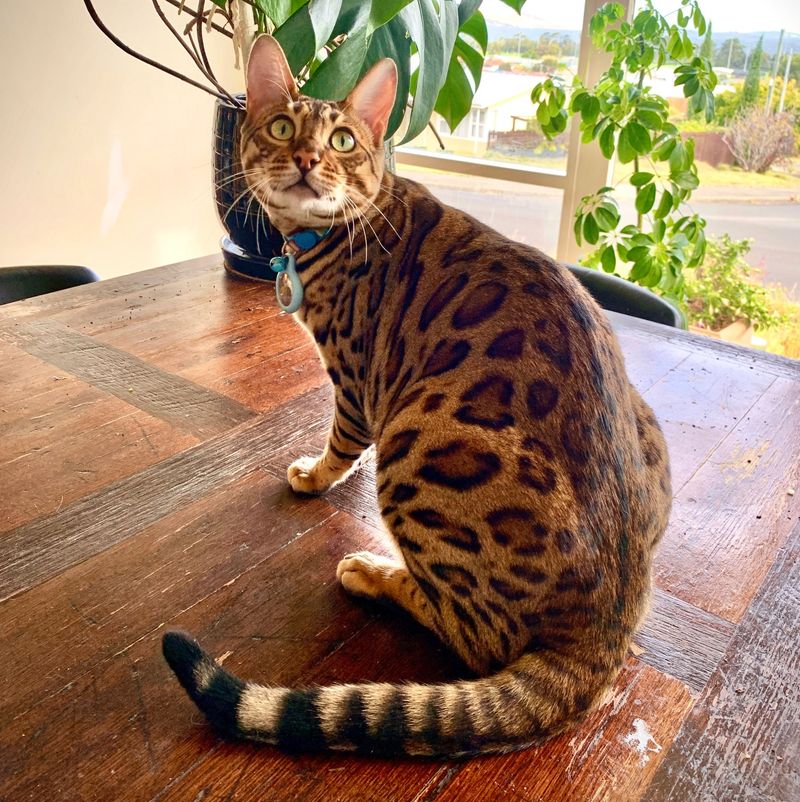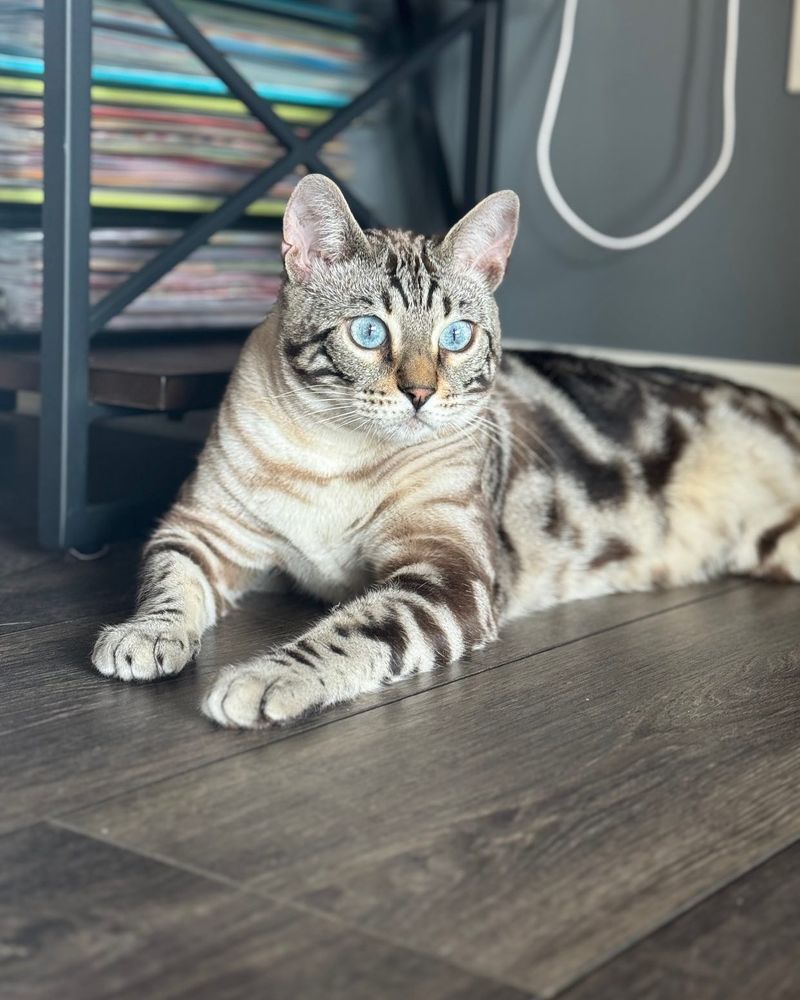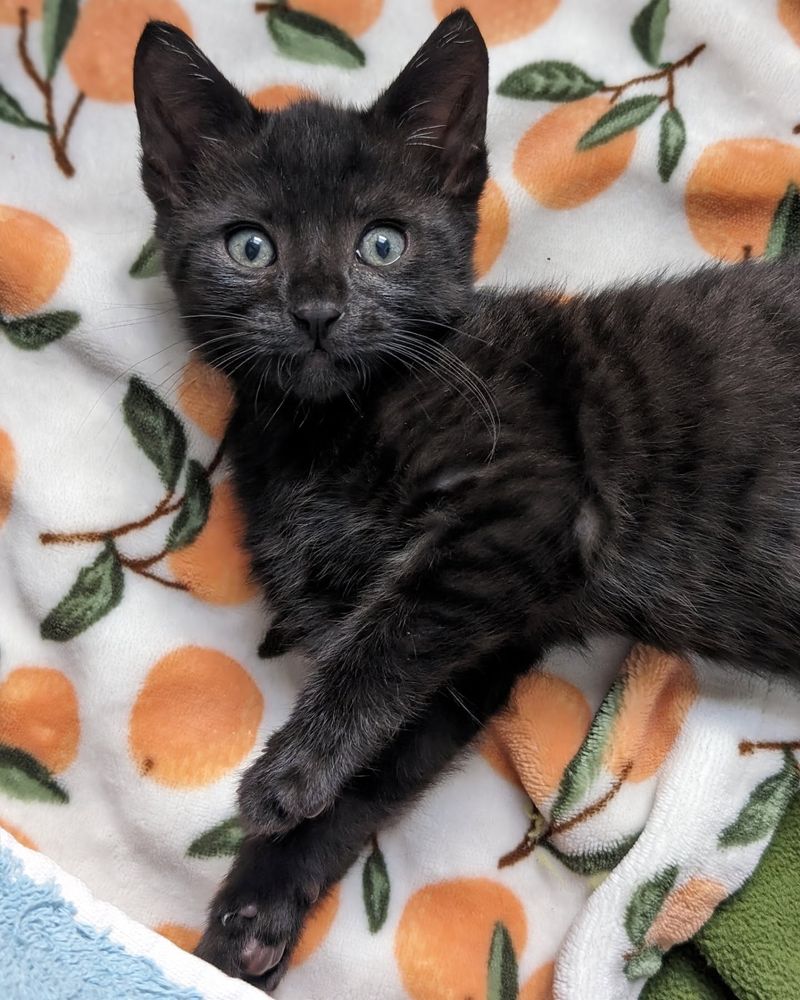📖 Table of Content:
- 1. Silver Smoke: The Magical Color-Changing Coat
- 2. Chocolate Point Siamese: The Rich Cocoa Beauty
- 3. Tortie Point: The Multi-Colored Masked Marvel
- 4. Chinchilla Persian: The Diamond-Dusted Aristocrat
- 5. Fawn: The Delicate Dusty Rose
- 6. Amber: The Color-Changing Norwegian Forest Cat
- 7. Rosette Bengal: The Mini Leopard Marvel
- 8. Cinnamon: The Warm Spice Rarity
- 9. Marble Bengal: The Flowing River Pattern
- 10. Ghost Tabby: The Phantom Pattern
Cats already captivate us with their mysterious personalities and playful antics, but some felines stand out even more thanks to their unusual coats. Beyond the common tabbies and solid-colored cats we regularly see, nature occasionally creates truly spectacular color combinations and patterns that can make even non-cat-lovers stop and stare.
These rare genetic variations not only make these cats visually stunning but also highlight the amazing diversity within the feline world.
1. Silver Smoke: The Magical Color-Changing Coat
At first glance, a silver smoke cat appears to be solid black or dark gray. But when they move or you stroke their fur, something magical happens! The silvery white undercoat suddenly reveals itself, creating an ethereal smoke-like effect that seems to shift and flow with every movement.
This striking coloration comes from hair shafts that are white at the base and colored only at the tips. The contrast between the pale roots and dark tips creates that distinctive smoky appearance cat enthusiasts adore.
Silver smoke cats often have intense eye colors that pop against their dramatic coats, typically copper, gold, or green. This rare coloration can appear in several breeds, including Persians, Maine Coons, and British Shorthairs.
2. Chocolate Point Siamese: The Rich Cocoa Beauty
Chocolate point Siamese cats showcase a warm, milk-chocolate brown on their ears, face, paws, and tail that contrasts beautifully with their creamy body color. Unlike the more common seal points with their almost black extremities, chocolate points display a softer, more velvety brown tone that resembles melted chocolate.
The gene responsible for this coloration is recessive, making true chocolate points less common than their seal point cousins. Their striking blue eyes seem even more intense against the rich brown mask.
Fun fact: Chocolate points are born completely white! Their color points develop gradually as they age, with the full pattern usually appearing by 1-2 years of age, thanks to a temperature-sensitive enzyme in their fur.
3. Tortie Point: The Multi-Colored Masked Marvel
Imagine a cat with the elegant pointed pattern of a Siamese but with tortoiseshell patches of red and black (or chocolate) on those points instead of a solid color! That’s the captivating tortie point pattern, creating a cat that looks like it’s wearing a multi-colored mask.
Almost exclusively female due to the genetics behind tortoiseshell coloration, these cats combine the best of two distinctive patterns. Their bodies maintain the lighter coloration typical of pointed breeds, while their extremities showcase the mottled tortoiseshell pattern.
Breeds that commonly display this unusual pattern include Siamese, Ragdolls, and Birmans. Each tortie point cat has a completely unique pattern, making them truly one-of-a-kind feline companions with personalities often described as fiery and independent.
4. Chinchilla Persian: The Diamond-Dusted Aristocrat
Resembling tiny snow leopards, Chinchilla Persians wear a coat that appears to have been dusted with diamond powder. Their fur is white at the base with just the very tips tinted in black, creating a sparkling, silvery appearance that catches the light beautifully.
The most distinctive feature of these rare beauties is their makeup-like facial appearance. They have black-rimmed eyes that seem enhanced with perfect eyeliner, and their nose and lips often have delicate black outlines too.
Originally developed in the UK in the 1800s, true Chinchilla Persians are among the most challenging coat patterns to breed correctly. Their emerald or blue-green eyes combined with their shimmering coat make them look like living jewels, earning them a special place among cat enthusiasts and in show rings worldwide.
5. Fawn: The Delicate Dusty Rose
Fawn-colored cats display a unique warm beige to light pinkish-brown coat that’s incredibly rare in the feline world. This delicate color resembles that of a young deer, which is where the name comes from. The shade varies from a warm tan to a cooler lilac-tinted beige, depending on the cat’s genetic makeup. This coloration appears most commonly in Abyssinians, Burmese, and Oriental Shorthairs.
The fawn gene is a dilution of the chocolate color gene, making it a recessive trait that requires specific breeding to appear. Fawn cats often have paw pads and nose leather in matching rosy-pink tones that complement their coat color perfectly. Their unusual coloring tends to highlight their muscular build and elegant movements, making them stand out even in a room full of cats.
6. Amber: The Color-Changing Norwegian Forest Cat
Amber coloration is so rare it’s found almost exclusively in Norwegian Forest Cats! These felines are born with dark black or blue coats that gradually transform over their first years of life into a warm golden-amber color, similar to maple syrup or honey.
This genetic marvel occurs due to a unique mutation discovered in Norwegian Forest Cats in the early 1990s. The transformation can take up to two years to complete, with some cats showing patches of changing color during the process, creating a fascinating patchwork effect.
Cat enthusiasts are particularly drawn to amber cats because of their changing appearance – it’s like having multiple cats in one! Their eyes typically maintain a deep green or gold color that complements their final amber coat perfectly, creating a truly magnificent forest creature.
7. Rosette Bengal: The Mini Leopard Marvel
Rosette Bengals showcase nature’s artistry with their wild-looking spotted coats that mimic those of their leopard ancestors. Unlike regular spotted patterns, true rosettes form distinct clusters where spots create a donut-like shape – an outer circle of dark color surrounding a center of lighter fur.
These mini-leopards owe their spectacular pattern to their Asian leopard cat ancestry. The highest quality rosettes are called “clouded” rosettes, which have thick, bold outlines similar to those seen on clouded leopards in the wild.
Each Bengal’s rosette pattern is unique, like a fingerprint. The background color can range from golden to silver, creating different effects that showcase the rosettes. Despite their exotic appearance, these domestic cats maintain playful, affectionate personalities that blend wild beauty with household companionship.
8. Cinnamon: The Warm Spice Rarity
Cinnamon cats display a warm, reddish-brown coat that truly resembles the beloved spice they’re named after. This coloration is one of the rarest in the cat world, resulting from a specific gene mutation that’s even less common than chocolate coloring.
The warmth of a cinnamon coat is unmistakable – neither as dark as chocolate nor as orange as red tabbies. Under sunlight, these cats seem to glow with a warm, spicy hue that makes them stand out from more common colorations.
Most frequently found in Oriental breeds and Abyssinians, cinnamon cats often have pink-toned nose leather and paw pads that complement their unique coat color. Their rarity makes them highly sought after by cat enthusiasts who appreciate unusual colorations, though the friendly personalities of these cats are equally valuable!
9. Marble Bengal: The Flowing River Pattern
Marble Bengals display one of the most striking patterns in the domestic cat world – swirling, flowing lines that resemble a rushing river or molten lava. Unlike the more common spotted Bengals, marbles feature dramatic swirls and elongated patterns that stretch across their bodies in unpredictable, artistic formations.
The pattern comes in three main variations: reduced marble with minimal markings, classic marble with bold, defined swirls, and the highly prized horizontal flow marble, where the pattern seems to flow horizontally across the cat’s body like water. Originally developed from the wild Asian leopard cat’s genetics, this pattern has been refined through selective breeding to create these living works of art.
Each marble Bengal displays a completely unique pattern, making them truly one-of-a-kind companions with the playful, active temperament that Bengals are famous for.
10. Ghost Tabby: The Phantom Pattern
Ghost tabbies appear at first glance to be solid-colored cats, but look closer in bright light and you’ll discover the secret – faint, almost invisible tabby markings hiding beneath their seemingly solid coat! This phantom pattern creates a mysterious, ethereal quality that cat lovers find enchanting.
This unusual effect occurs in solid-colored cats carrying the agouti gene, which normally creates the distinct tabby pattern. In ghost tabbies, the solid color gene masks most of the pattern, leaving just a hint visible under certain lighting conditions.
Black cats most commonly display this phenomenon, showing shadowy tabby markings that seem to appear and disappear like ghosts. Some cat owners don’t even realize their solid black cat is actually a ghost tabby until they spot the hidden pattern while their pet lounges in bright sunlight!
